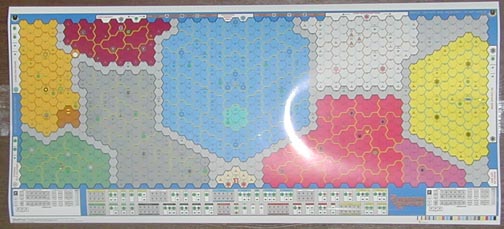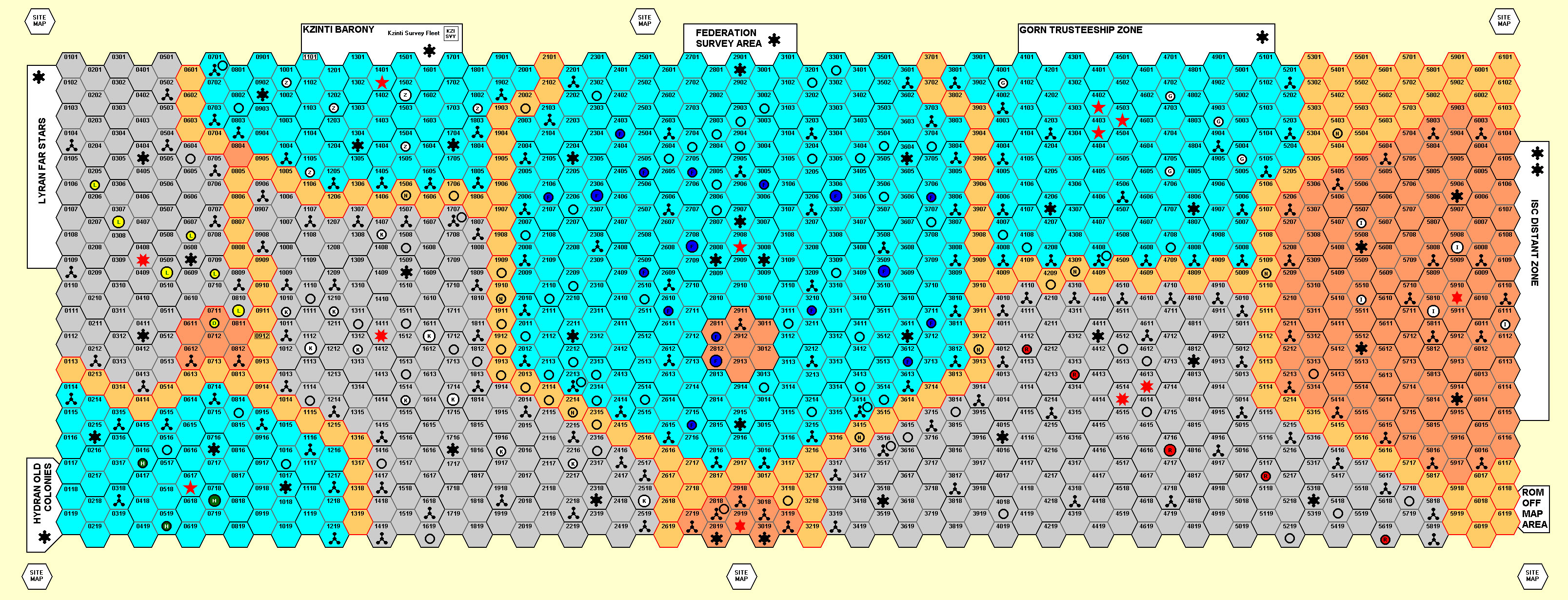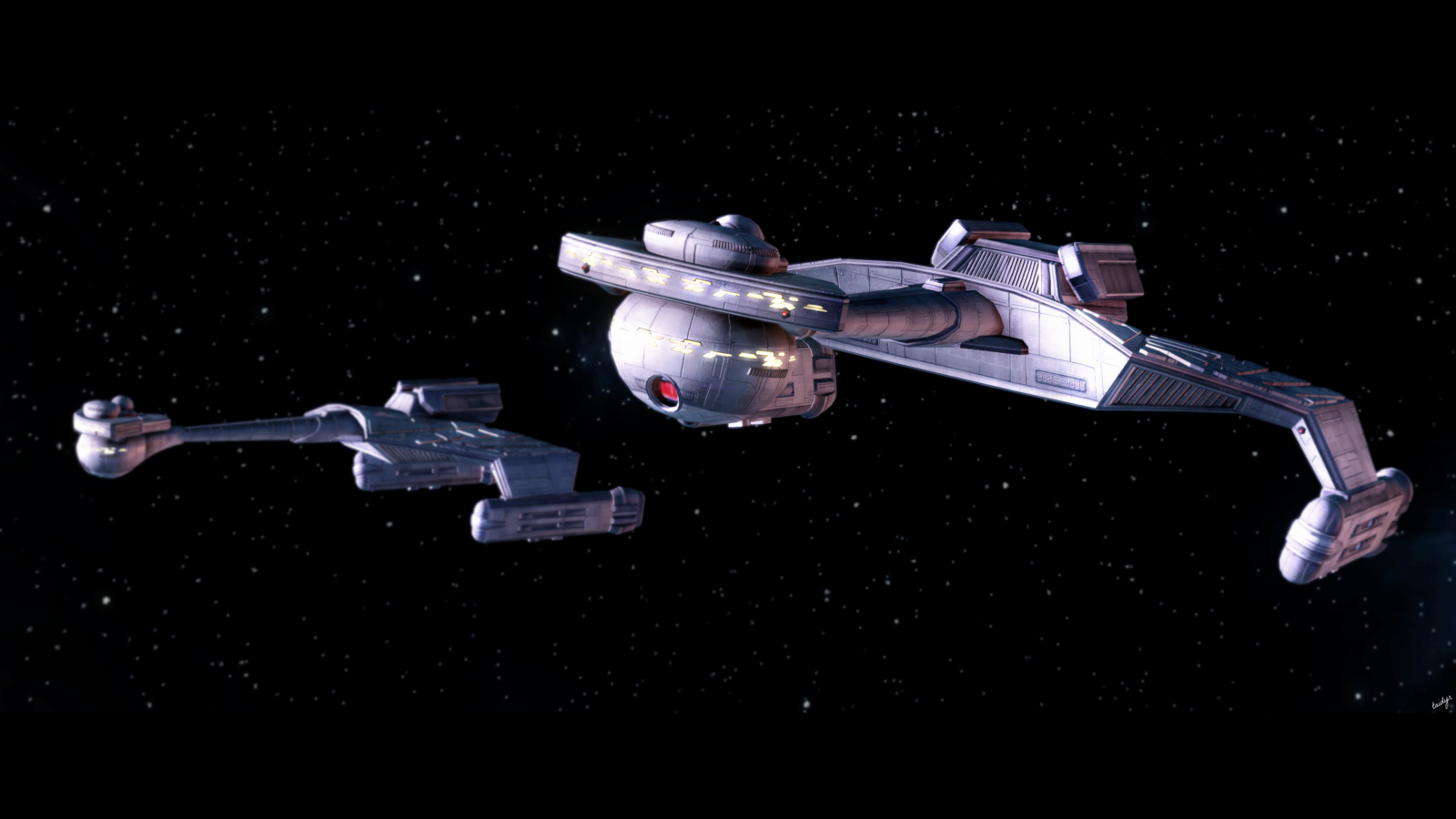The age of the Original Series is a very interesting era of Star Trek with several fan made designs and lots of unofficial contents, there is so much to work with! Currently I’m working mostly on the models. I’m mostly finished with the Federation, while the Klingons and the Romulans are well underway. But modeling is the easiest part of creating a new Ear because most of the ships I’m using are the works of other talented modders, all I have to do is port them properly to Armada. Ideally all I have to do is to add hardpoints, work a bit on the illuminations and reflections and it’s done. Occasionally I make my own models, which is always exciting, but of course, more time consuming. Modeling is the most rewarding part of creating a mod. The struggle comes at balancing and coding…
I don’t want to give away any details about the fleets just yet, because balance is not written in stone yet, so let’s take a look instead at the key event of this Era, the General War.
The General War was a quadrant-wide galactic struggle originally invented by Amarillo Design Bureau Inc. for their grand-strategy board game, Federation and Empire which have seen several reprints and expansions, the last batch being released in 2010-11. Although it is not part of the official Star Trek canon, it is still a very interesting story worth implementing in the mod.
Evolution Background
Let’s take a look at the representation of the Alpha Quadrant as the board game understands it, and let’s see how it fits into Evolution’s own timeline. For this, we're going to use the game's actual play board. It represents pretty nicely the relevant part of the Alpha Quadrant, and with some creative thinking, it can be reasoned how it fits into the later development of the universe as we know it. Surprisingly, there are no good images about the map on the internet, so we'll have to deal with what we find.

The recently born Federation (shown in blue above) occupies the center of the play area. They expanded into uncontested space in the last century, occupying the area between two major regional powers, the Klingon Empire (in grey) and the Romulan Star Empire (in magenta). Although its territory and population was the greatest and economy is the strongest, most of the outlying Federation colonies were still too young with population more often in the thousands rather than in the millions, making these planets easy prey for any invading force. Easy to take, easy to keep, and already having the necessary infrastructure, they could worth the risk of a quick incursion… The Klingon Empire had heavily fortified planets but limited space for expansion. They were also locked in a long conflict with the Kzinthi (in purple) to their “North” and the Lyrans (in sand yellow) and Hydrans (in green) to the “West”. In addition, the Tholians (in yellowish-white) had a strong foothold, just wedging between the Klingons and the Romulans. The Romulan Star Empire had vast territories not represented on the board, but they were threatened by the Federation, the Gorns (in white) and the Interstellar Concordium (in cadmium yellow), an alliance of several races in the Beta Quadrant that was significantly strengthened thanks to several planets, defecting from the Star Empire after the Terran War.
Chronology
The tension was gradually growing in the Alpha Quadrant during the 23rd century. A series of Four Powers Wars among the Hydran, Lyran, Klingon and Kzinthi in various constellations was a constantly boiling pot, but tensions rose even more as the aggressively expanding Federation started to challenge Klingon interests along their border, and openly started to negotiate with the Kzinthi.
In 2232 the Lyrans formed The Coalition with the Klingon Empire and attacked the Kzinthi Barony to quickly conquer them, rather than letting them slide into the Federation’s sphere of interest. After early victories, they invaded the Hydrans as well who in turn formed the Alliance with the Kzinthi. The Coalition made significant gains in the first two years, making the Klingons bold enough to continue their ongoing on-again-off-again conflict against the Federation, drawing forces away from the actual war. As a response, the Federation started to openly support the Kzinthi war effort with supplies and previously mothballed ships.
In 2234 the Klingon Empire, citing a casus belli of already being involved in the war, made a full-scale assault on the Federation borders. However,t his attack didn’t catch Starfleet unaware, and despite making initial gains and destroying several outposts, the Imperial Fleet was stopped not far from the original borders. The Federation formerly joined the Alliance and sent several fleets into Kzinthi territory. Now missing badly those Klingon ships that were relocated to the Federation border, the Coalition has no choice but to give up the siege of the Kzinthi home world. However, in the same year, the Federation suffered a significant loss when the Orion Pirates took control of several planets in the Federation heartland and declared themselves independent. Not having the necessary resources to recapture those planets, all the Federation could do was to try to isolate the newly formed Orion “state”.
The next year the Coalition advance completely stopped on every front. At this point they effectively crushed the Hydran resistance, controlled more than half of the Kzinthi Barony and almost reached the Romulan border. However, the Federation only reached full mobilization of Starfleet at this point and started to push back Klingon forces, threatening with a breakthrough. This was enough for the Romulan Senate to finally answer the call of the Klingon Chancellor and joined the Coalition. However, as Starfleet was already aware of the negotiations taking place (in fact they tried to capture the Klingon ambassador), invading Romulan fleets met heavy opposition. It worth mentioning though that the Romulans were quite cautious not to reveal their cloaking technology or their Vulcan heritage, so they have turned away several times when the battle could still have been won.
In 2236 the Alliance gained a new member in the Gorn. In the same year however, Orion pirates started to swarm out from their quasi-state, adding to the problems of the Federation. Bellow you can see the Coalition in grey and the Alliance in light blue. You can also see the neutral ISC to the East, the Tholians to the West, the Orion planets in the middle of the Federation and the Lyran Democratic Republic to the West, which declared its independence form the Lyran Star Empire and remained neutral during the whole conflict.

By the end of 2238 the Hydran worlds were in ruins, the Kzinthi Barony was still torn into two pieces and the Gorn had trouble keeping the Romulans at bay while the Federation couldn’t free up enough ships from the Klingon font to help out. The Alliance managed to recapture most of the initially lost Federation territories however, and with a daring move, a fleet managed to break through the Klingon line sand reach the Federation-Tholian border, cutting the lines of the Coalition. Moreover, the Tholians agreed to support the Alliance and not to allow any Coalition ship through their territory.
As an answer, the Coalition launched a massive offensive against the Tholian in 2239. The attack got stalled and direct contact between the Romulans and their allies wasn’t reestablished before the end of the General War. The same year the Romulans used their secret weapon the first time: A cloaked fleet penetrated Federation lines and made a strike on the undefended world of Rigel IV. However, being under strict orders not to reveal the existence of the cloaking technology, the Romulan admiral decided to withdraw behind friendly lines after some minor victories.
In 2240 the cloaking device yet again played a major role. The Romulans used it to lure into a trap and wipe out a huge Gorn fleet, opening the way to a major invasion of Gorn space. To halt the Romulan advance, in the next two years the Alliance gradually diverted ships from the Western to the Eastern front, which eventually meant that advancement on the Western front became impossible.
By 2243 the Alliance managed to drive the Romulans out of Gorn space and a plan to completely break the Romulan fleet and force the Star Empire out of the war was drawn up, but the the Kzinthi ships, seeing the Eastern front secure, decided to return to the defense of the Barony, stalling the Alliance advance into Romulan space, even before it begun.
This turned out to be the last major event of the General War. Although the war raged on for seven more years, it gradually became nothing more than a senseless bloodbath where neither side could gain a decisive advantage, similarly to the trench war of World War I. The last big push in the war was made by the Klingons in 2246 when they tried once again to capture the Kzinthi homeworld, but their efforts were thwarted by Alliance forces.
The exhausted parties signed the peace treaty on the 7th of June, 2247. As the frontlines were frozen for years almost exactly at the pre-war borders, nobody gained any territory, even though the Lyrans were lobbying very hard to keep their gains in Hydran space.
Aftermath
The General War affected every participant differently. The Interstellar Concordium, that remained neutral during the conflict, considered the war to be proof that its “savage” neighbors are unable to live in peace. Formed by several worlds, the ISC fleet was advanced and untouched, so they thought the time was right to pacify the Alpha Quadrant. They did this by forming a claim on every unclaimed or contested territory and sent their fleets to validate those claims in 2248. The plan was to take control of the neutral zones and border areas everywhere, isolating every party from each other. However this grandiose plan wasn’t welcomed by anybody, and despite the fact that the ISC managed to project its control over the Alpha Quadrant for a few short months, their fleet was quickly eroded by the many minor conflicts they provoked. By 2250 the ISC fleet was all but destroyed the great pacification campaign failed and in the next decade the Concordium itself fell apart.
The Kzinthis never managd to recover from the ravaging war and the Barony eventually joined the Federation in 2261. The Hydran and Lyran fleets were practically non-existent at the end of the war, and they became easy prey when a planet formerly enslaved by the Lyrans, called Cardassia rebelled and started an expansion in the power vacuum.
Losing their allies, the Klingons were forced behind their borders but they didn’t consider the score settled with the Federation, especially after the Kzinthi Barony’s peaceful annexation. The era between the General War and the signing of the Kithomer Accords in 2293 is called the Federation-Klingon cold war for a good reason, because border conflicts were part of everyday’s routine in these years. This latent conflict was heated up twice, when the parties declared war on each other. The first conflict was called the Four Years War, started by a Klingon attack against the Federation colony of Archanis IV in 2256. The war was eventually settled by a peace treaty with only minor border changes. The other occasion was the so-called Four Days War (described in the TOS episode Errand of Mercy, pictured bellow), which was ended by the Organians in 2267 as soon as it was started. The subsequent peace treaty stabilized the Federation-Klingon border region and eventually made it possible to sing the Kithomer Accords.
Speaking of them, every expert on the matter agrees that the General War ended in the last moment before the Federation would have succumbed into chaos. Starfleet was completely bogged down fighting on two fronts and they had no strength left to pacify the Orions or to safeguard planets form pirates. In addition, shortage in supplies started to form, meaning that if the conflict would have prolonged any more, martial law would have to be enforced to keep Starfleet up and running. That would have been the end of a democratic interstellar entity. Although the worst was avoided, the result was a much more cautious Federation that wanted to avoid military conflict whenever it was possible. Although this helped to prevent several minor conflicts (with the Klingons, the Tholians, or the Gorn) to escalate, some scientists say that the Federation’s inability to recognize when to act was also the cause of many other conflicts, like the subjugation of Bajor, the Cardassian War, the near extinction of the Tholians, or the Dominion War.
The Gorn survived the war in surprisingly good shape, considering especially that the front wandered though half of their territory twice. However the following attack of the ISC caught them unaware and they suffered the greatest losses in the conflict.
In the Romulan Star Empire a pro-democratic group decided that the exhaustion of the state was the perfect opportunity and they organized a coup d’état. After taking control of the Senate and most of the civilian government, they quickly reformed the Star Empire into a democratic republic and announced an empire-wide general election for the 3rd of January 2248. It’s the Day of Foundation, when, according to the legends, Romulans set foot on Romulus the first time. But in fact the support of the new government was negligible in the populace and nonexistent among the military. The people wanted peace and a chance to recover instead yet another conflict. So when High Admiral Torev, the highest ranking officer in the Star Navy, returned with the remainder of the Imperial First Fleet and took Romulus under blockade, the people quickly turned against the new government. Torev had no problem rounding up the insurgents within a few days and execute all of them. Then he promptly appointed himself Praetor with the support of the Fleet and (most of) the political elite.
I'll try to write t least one dev diary per month, but with my hands full, I may break my rule on the first occasion... But don't let this discourage you, I'll still answer any question you may have in the comments or PM ;)
k_merse



This comment is currently awaiting admin approval, join now to view.
interesting read, is all of that information purely from the board game or does it also (at least partly) corroborate with other forms of canon?
also congratulations on your new son
The General War is purely fictional, it appears only in Federation & Empire. Tying it to the actual canon was invented by me and that necessarily has some canon elements.